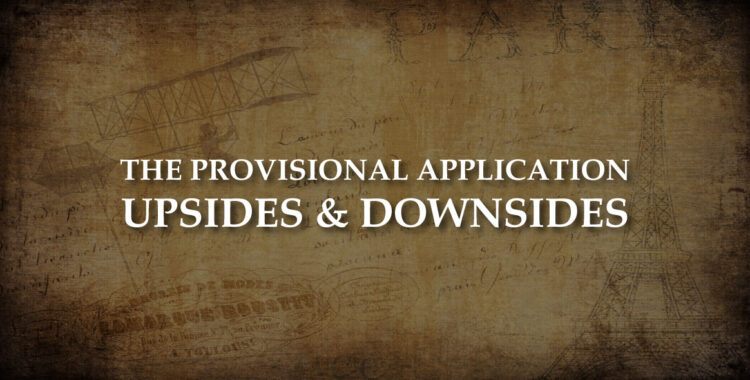Upsides and Downsides To The Provisional Patent Application
“Should I just file a provisional application to save some money?”
Some quick background: A provisional application is one that is filed and lasts for 12 months. It cannot be extended beyond 12 months and remains secret in the USPTO during its pendency. It does allow the inventor to use the “patent pending” designation and provides all other property rights associated with being patent pending such as the ability to obtain a license or warn an infringer that a patent application has been filed which would be infringed upon should it issue as a patent. However, before the 12 months expires, it must be converted into a non-provisional patent application by filing the non-provisional and claiming the filing date of the provisional application. Failure to file the non-provisional application will lead to an abandonment and loss of the provisional application filing date.
Upsides to the provisional application.
The answer as to whether you should file a provisional application depends on your situation.
Provisional applications are definitely less expensive to file because they do not require formal drawings or a complete set of claims
A non provisional patent application includes drawings, a specification, and a claim set. The specification is the body of the application providing definitions and examples and, more generally, a normal English version of your invention. The claims define what is actually being protected by the patent that ultimately issues and are amended and argued over with the Patent Examiner. For a provisional application, the claims are not needed and the drawings are often those drawings supplied by the inventor. This, in turn, leads to a lower overall cost of preparation. Also, because the USPTO does not look at a provisional application outside of ensuring all parts have been properly filed, the government fees are quite low.
Thus, a provisional application is less expensive and can typically be filed more quickly compared to a non-provisional patent application.
Downsides to the provisional application.
First, a provisional still must be as complete and accurate as possible because if the non-provisional relies upon the provisional, and if information or corrections are added to the non-provisional, the filing date of the provisional will be lost. This can lead to serious consequences if the inventor relied upon the filing date of the provisional application and made the invention public before the filing of the provisional application. For example:
- The inventor makes the invention public on January 1st, 2022. This starts a non-extendable 1-year clock (i.e. the one-year bar date) for the filing of a patent application.
- A provisional application is filed 6 months later on July 1st, 2022.
- An oversight omits a crucial feature or the application is written so narrowly that it is easily circumvented.
- After January 1st, 2023, and before July 1st, 2023, a non-provisional application is being prepared and the deficiencies are discovered. Because the invention has been public for more than 12 months, the non-provisional application cannot be amended to correct the deficiencies, the filing date is lost, and no new application can be filed because the inventor is outside the one-year bar date. The result could be a complete loss of protection for the invention.
Second, while the application is pending for 12 months, the inventor only actually has about 10 months because the patent attorney is going to require 1-2 months to convert the application to the non-provisional and this must be completed before the expiration of the 12 months. As is often the case, the inventor realizes that the 12 months goes by extremely fast and is put in a position of having to file the non-provisional application anyway, thereby adding to the overall costs of the process.
Third, a provisional application is never examined by the USPTO and when the non-provisional application is filed, the USPTO views it as a new filing. This means that your examination is delayed by up to 12 months. Therefore, if you were in a hurry to obtain a patent, you would not want to file a provisional application.
Fourth, if the goal is ultimately to obtain a patent, the filing of the provisional application not only delays the timeframe but adds to costs since the provisional and non-provisional applications are usually billed separately and ultimately leads to overall increased costs..
Intellectual Property Playbook
An Entrepreneur's Guide To Patents, Trademarks, and Copyrights GET THE PLAYBOOK
A Note From Attorney Sean Kaufhold:
 It has been my experience that nearly all clients who filed a provisional application have eventually come back and filed a non-provisional application because they are still in the process of getting their invention off the ground and do not really have much more insight as to possible success than when they filed the provisional. This meant they delayed the prosecution and spent more on legal and government fees that could have been avoided by originally filing the non-provisional application.
It has been my experience that nearly all clients who filed a provisional application have eventually come back and filed a non-provisional application because they are still in the process of getting their invention off the ground and do not really have much more insight as to possible success than when they filed the provisional. This meant they delayed the prosecution and spent more on legal and government fees that could have been avoided by originally filing the non-provisional application.








